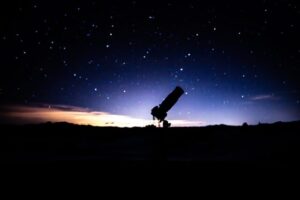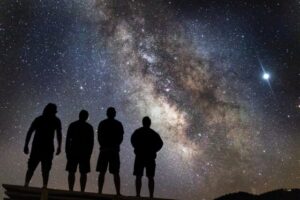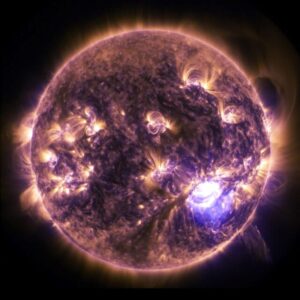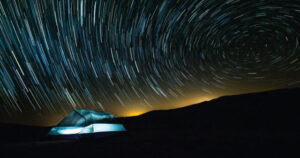In this artist's conception, a carbon planet orbits a sunlike star in the early universe. Young planetary systems lacking heavy chemical elements but relatively rich in carbon could form worlds made of graphite, carbides and diamond rather than Earth-like...
A sequence of snapshots from a simulation showing a red giant star tunneling through a high density gas clump. The star is moving downward in the illustration, as indicated by the bow-shaped "onion skin" surfaces of constant density. Soon...
Image around SN 2012dn obtained by the Kanata Telescope at Higashi-Hiroshima Observatory. SN 2012dn is seen near the center of this figure. The host galaxy ESO 462-G016 is seen on the left side of SN 2012dn. The distance to...
Spiral galaxies like the Milky Way are shown in the center, surrounded by the circumgalactic medium, which appears as black to our eyes. However, the circumgalactic medium contains very hot gas, shown in red, orange, and white that outweighs...
It's rare that such different objects are imaged so close together. Such an occasion is occurring now, though, and was captured two days ago in combined parallel exposures from the Canary Islands of Spain. On the lower right, surrounded...
A multinational team of astronomers has found an Einstein Ring, a rare image of a distant galaxy lensed by gravity. The scientists, from Spain, Italy and the USA, report their discovery in Monthly Notices of the Royal Astronomical Society.
In...
The VLA radio map of the region around the Great Red Spot in Jupiter's atmosphere shows complex upwellings and downwellings of ammonia gas (upper map), that shape the colorful cloud layers seen in the approximately true-color Hubble map (lower...
This illustration shows the three steps astronomers used to measure the universe's expansion rate to an unprecedented accuracy, reducing the total uncertainty to 2.4 percent. Astronomers made the measurements by streamlining and strengthening the construction of the cosmic distance...
Artist's impression of the galaxy.Credit: ICRAR/Peter Ryan
An international team of scientists has pushed the limits of radio astronomy to detect a faint signal emitted by hydrogen gas in a galaxy more than five billion light years away -- almost...
An image taken by the Ralph/Multispectral Visual Imaging Camera (MVIC) on NASA's New Horizon spacecraft shows Sputnik Planum.
Credit: Image courtesy of NASA/Johns Hopkins University Applied Physics Laboratory/Southwest Research Institute
On Pluto, icebergs floating in a sea of nitrogen ice are...
A new study led by Purdue and CU-Boulder researchers shows that comet splitting and reuniting may be fundamental to comet evolution. Credit: ESA/Rosetta/MPS for OSIRIS Team MPS/UPD/LAM/IAA/SSO/INTA/UPM/DASP/IDA
For some comets, breaking up is not that hard to do.
A new study...























